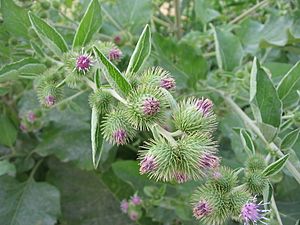Lesser burdock facts for kids
Quick facts for kids Lesser burdock |
|
|---|---|
 |
|
| Flower heads | |
| Scientific classification | |
| Genus: |
Arctium
|
| Species: |
minus
|
| Synonyms | |
|
Synonymy
Arcion minus Bubani
Arctium chabertii Briq. & Cavill. Arctium conglomeratum Schur ex Nyman Arctium euminus Syme Arctium lappa Kalm 1765 not L. 1753 Arctium montanum Steud. Arctium pubens Bab. Bardana minor Hill Lappa minor Hill Lappa pubens (Bab.) Boreau |
|
The Lesser Burdock (scientific name: Arctium minus) is a common plant. It is also known by other names like little burdock or common burdock. This plant is a biennial, which means it lives for two years.
Lesser burdock originally comes from Europe. However, it has spread to many other parts of the world. You can now find it in places like Australia, North America, and South America.
Contents
What Does Lesser Burdock Look Like?
This plant can grow quite tall, up to about 1.8 meters (nearly 6 feet). It often looks large and bushy. In its second year, from July to October, it grows purple flowers.
Flowers and Seeds
The flowers are prickly and range from pink to lavender in color. Each flower head is about 2 centimeters (0.8 inches) wide. After the flower dries, its outer parts have tiny hooks. These hooks are very similar to Velcro.
When animals or people brush past the dried flower heads, the hooks grab onto their fur or clothes. This helps the plant spread its seeds far away. It's a clever way for the plant to travel!
Leaves and Roots
Lesser burdock has very large leaves. They can be up to 50 centimeters (about 20 inches) long. The lower leaves are shaped like a heart and have wavy edges. The top of the leaves is dark green, and the underside feels woolly.
The plant also grows a very deep main root, called a taproot. This root can go down into the ground for about 30 centimeters (12 inches) or more.
How People Use Lesser Burdock
Some parts of the lesser burdock plant can be eaten.
Edible Parts
The young leafstalks (the part that connects the leaf to the stem) can be eaten. You can eat them raw or cooked. The flower stalks can also be prepared and eaten.
The roots of young plants (less than a year old) are also edible. They are usually boiled, and it's best to change the water during cooking. Older roots become too tough and woody to eat.
See also
In Spanish: Lampazo menor para niños

